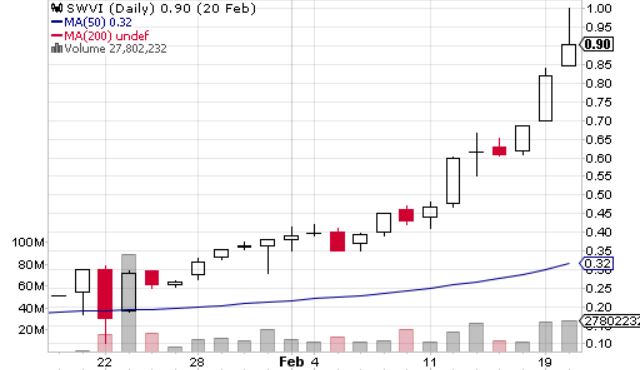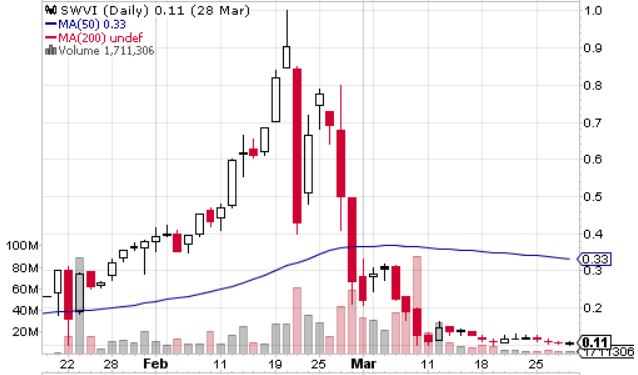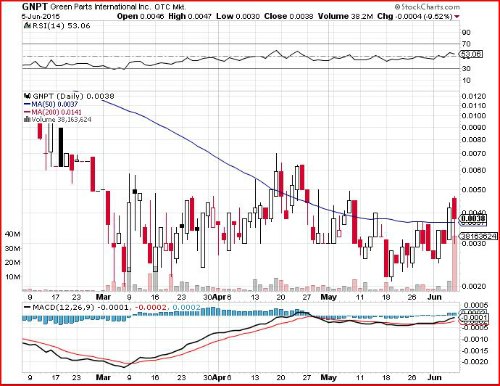Penny Stock Trading
Strategy for MAX Profits!

A good penny stock trading strategy is invaluable to help you maximize your profits. There are numerous strategies that can make you money and all you have to do is pick one that you're comfortable with, master it and watch your account grow!
What a fun and potentially extremely profitable game trading penny stocks is! Once you find a penny stock trading strategy that you are comfortable with, then you can regularly supplement your income with it and/or make a full time living.
As we've discussed in earlier lessons trading on the OTC Markets comes with some big risks, so don't think it is an automatic that you'll make money...it takes time to learn how to play this game. To reiterate just some of the rules of the road:
- Don't get greedy!
- Take profits often (you can't go broke taking profits)!
- Don't buy in for more than 5% of the average daily volume (liquidity is essential)!
- Don't believe the hype...Trade the hype!
- Don't chase the share price!
- Do buy on pullbacks at key support levels and/or trendlines (all stocks pullback).
- Always use limit orders when buying or selling on the OTC.
- Always have an entry and exit plan before you put your money in.
- Nearly ALL penny stocks will fail or are outright scams...Do not fall in love with any of them!
Let's take a look at what type of trader you are and/or the type of trader you aspire to be. To skip directly to the different strategies, click here penny stock trading strategy.
What Kind of Stock Trading Strategy Works Best for You?
There are essentially four types of stock trading strategies that you can use and it's worth it to get an idea of what strategy will work best for you so as you learn you can really focus on how to improve as that type of trader.
- Day Trader
A day trader is someone that typically will buy and sell a security in the same day. They rarely hold positions overnight, they need to be in a position to monitor trading activity closely and they need to be pretty darn good at charting.
This style of trading is more advanced and not really a great penny stock trading strategy if you have a day job. It's far too easy to get distracted at work and your stock take a sharp turn for the worst before you have the opportunity to sell. I would suggest this NOT be the strategy for beginners.
In addition to day trading being an overall more advanced style of trading you'll have to be aware of the "Pattern Day Trader" rule. Four or more trades in a margin account, with less than $25,000 in equity, in a 5 trading day span and your account will be restricted. - Swing Trader
A swing trader will typically hold a stock for a few days to a few weeks and buy in anticipation of a technical move (related to charting and indicators) and/or some sort of catalyst, such as news.
This is my preferred method of trading as I do have a day job and this has been a highly successful strategy for me with an average return of 65% per trade. Only down side to this is the wait and the inactivity while waiting. - Long
Long term traders are ready to wait weeks to months for a stock to develop. This can be a very effective strategy, but you need to regularly keep up with the company to make sure the company's goals or time frames don't change from what you were originally planning.
For instance, if a Letter of Intent (LOI) were signed today and the company said the closing should take place in two months, stay on top of it to make sure the deal doesn't fall apart. If it does, then hit the road quickly...unless of course there are other reasons to stick around.
Also be sure to not get time bound. By this I mean that after three months of holding a stock don't feel obligated to wait another month just to see if that news you were waiting on comes...It's easy to start dreaming about a wildly successful press release coming any day, but if there is a major delay, it usually means the deal fell through or wasn't real to begin with.
This can be an extremely profitable penny stock trading strategy as you can buy in for a nice sized position cheaply before the buying frenzy begins. Personally, for me to use this strategy, I'm wanting to get at least a 100% gain per month I expect to hold the stock...At Least 100% per month. Otherwise it is simply not worth it to tie up my money that long. - Short Selling
Short selling can also be an extremely profitable penny stock trading strategy, but it comes with a very LARGE RISK! You can lose more than your initial investment. It is the act of selling shares that you don't own, but you borrow, to bet against the stock.
If the stock goes down you make money, but if the stock were to explode and go up 300% and you had $500 invested you could end up owing your broker $1,500 if they don't forcibly close out your position before it gets that bad.
This is definitely a penny stock trading strategy for advanced traders and I wouldn't begin to experiment here until you have quite a bit more experience.
Specific Penny Stock
Trading Strategies
Buy the Pullback
A pullback is not so much a specific penny stock trading strategy (although it can be from a technical standpoint), but it is how you'll want to buy stocks vs. chasing them. Here is a stock chart of SWVI:

For the most part, looking here at the daily chart, the stock looks really solid, but if you would have bought at .90, .95 or been the very unlucky guy that was chasing (expecting this to break a dollar), then this is what you would have faced the following days:

Not Pretty! That's a 60% drop in one day
for our unlucky $1 buyer.
Stocks do not go straight up. You may see some of the longer candlesticks above and at first glance it would look like on some days it did, but in reality there was a lot of "chop" throughout each one of those days.
You see, in every stock there is someone looking to profit at some time in the future (buyers) and there is someone looking to profit now (sellers).
Throughout any given day, although the time frame may be short at times, there is a point were sellers overpower buyers and the stock will pullback. The goal is to buy at or near key support points, with confirmation that they are going to hold support, when a stock pulls back. (Support and Resistance are covered in the Charting Guide)
Let's get into some different penny stock trading strategies...
Trade the News
There are several ways to trade the news and this is the best penny stock trading strategy for me based on my daily schedule and my inability to watch my computer throughout the day.
- Wait for big news to break.
Watch the price and volume action and if an opportunity presents itself, then buy on a pullback. - Buy in anticipation of future news.
Often times a company will put out a press release or a filing that suggests more news is to follow in the days or weeks to come.
You'll find these suggestions in 10Q, 10K and 8K filings (or basic press releases) that state a LOI was signed with an expected closing date of XYZ. Or maybe it's a big product launch, or order shipment, an anticipated uplisting to a higher OTC tier...It doesn't necessarily matter what it is, but just that there is a major catalyst due in the near future.
Again, look to buy the stock on a pullback and other traders, in anticipation of this news, will at some point prior to the release generally run up the price enough for you to make a handsome profit.
You don't even need to wait for the news itself (frequently there never is news as deals fall apart or take much longer to put together or were just pipe dreams to begin with), just simply wait for the price to move 20-50%, sell and move on to the next.
I frequently use this penny stock trading strategy and it's almost always (depending on my entry price) given 30+% returns within weeks. This would be one of the easiest strategies for a beginner in my opinion.
Technical Analysis (TA)
Technical Analysis is a more scientific penny stock trading strategy and uses different math based indicators to assign values for traders to analyze.
Using technical indicators/analysis is an excellent way to spot stocks that are setting up for breakouts, are oversold, should be avoided, etc.
Some traders will tell you that technical analysis is irrelevant for penny stocks and everything is solely based on news and/or hype. They couldn't be more wrong!
Sure, news can trump technicals and/or chart patterns, but it is essential, let me repeat that...ESSENTIAL that you learn at least the basics about these crucial indicators.
Some of the most common you'll here about are MACD, RSI, Bollinger Bands, Money Flow, Stochastics and Moving Averages.
Trade Chart Patterns and Candlesticks
Combine chart patterns, candlesticks and technical indicators and you've got one powerful weapon to take on penny stocks, big board stocks, options and more. When a big picture is painted with all these combined it really shows you the markets from a psychological standpoint on a security.
Some of the more common terms you'll here are Trendlines, Support and Resistance, Flag Pattern, Wedge, Pennant, Head and Shoulders, Double Bottom, Three Stars in the South, Three Line Strike, Morning Star Doji...and trust me, the list goes on and on!
We'll cover TA and Charting in depth in separate guides...These are more advanced, but if you want to perfect any penny stock trading strategy, then you've got to have a solid understanding of the basics here.
Trade Stock Promotions
We just covered promotions in the previous lesson so I won't go in depth as to what they are, but it is extremely important to understand promoted stocks don't move like they used to. A few years back you could almost blindly throw your money into certain promoted stocks and pull a profit, but promotions have since cooled off to a degree.
If you do trade promotions, then definitely do not trade in the first 15 minutes and don't, Don't, DON'T chase them. There is typically a lot of chaos in the first 15-30 minutes and you want the dust to settle a bit and look for...you guessed it...a pullback before buying.
Personally, I would not suggest holding one of these overnight, unless there was really something that appealed to me about how the stock traded and I thought it might continue on into the next day.
Momentum Plays (MoMo Plays)
Probably the most popular penny stock trading strategy are momentum plays. This is where a lot of pros make their living and many newbies roll the dice.
When some sort of catalyst sets a stock into motion, news, promotion, rumor, message board pump or whatever gets it going, this gives an opportunity for traders to possibly ride the wave for some quick profits.
Most recently, I traded RIVT and bought in at .30 and sold at .45 within about 2 minutes. 50% in 2 minutes and the stock got halted the next day, because an unfounded rumor was floated that Tesla was going to be buying them. That's another reason I don't like to hold these or promotions overnight...SEC halts will wreck a stock!
Reversals
A reversal occurs when a stock has "bottomed out" and technical indicators along with volume suggest the stock is oversold and ready to go back up. This is similar to buying a pullback, but is usually on a longer time frame than an intraday chart.
Reversals also happen in the other direction and it's important to know what to look for before the bottom falls out of a penny stock that is overbought. For this lesson however, we are looking more at when to buy than sell.
Dead Cat Bounce
A dead cat bounce occurs when some sort of event causes a stock to gap down...The bigger the gap, typically the bigger the bounce. Once the stock has gapped down, about 50% of the time, the following day will also be a down day and if a bottom can be calculated, then you can buy in and expect the stock to try to fill the gap (i.e. go back up to where it was before it gapped down) before eventually heading back down.
This can be extremely profitable, but timing the bottom is not always an easy thing to do. This requires a fair amount of knowledge regarding technical analysis and/or charting, so I don't necessarily recommend this as a beginners penny stock trading strategy.
What Are Your Profit Goals?
On top of what type of stock trading strategy you expect to use it is important to set profit goals for your trades. I personally look to make no less than 20% per trade, but for many day traders they might be in and out throughout the day for 3-5% gains each trade.
Many people get into trading penny stocks expecting every trade to equal 100, 200 or even 300% and more per trade...You can do that, but that's not going to happen on a daily basis. Often, you have to give those a little bit of time to develop.
Let me show you just how powerful consistent weekly (possibly daily) 20% returns can be starting with only a $1,000 investment:
|
Week 1 |
$1,000 |
X |
20% |
= |
$1,200 |
|
Week 2 |
$1,200 |
X |
20% |
= |
$1,440 |
|
Week 3 |
$1,440 |
X |
20% |
= |
$1,728 |
|
Week 4 |
$1,728 |
X |
20% |
= |
$2,073 |
|
Week 5 |
$2,073 |
X |
20% |
= |
$2,487 |
|
Week 6 |
$2,487 |
X |
20% |
= |
$2,984 |
|
Week 7 |
$2,984 |
X |
20% |
= |
$3,580 |
|
Week 8 |
$3,580 |
X |
20% |
= |
$4,296 |
|
Week 9 |
$4,296 |
X |
20% |
= |
$5,155 |
|
Week 10 |
$5,155 |
X |
20% |
= |
$6,186 |
After looking at that chart and how powerful a simple 20% per trade gain can be I hope you truly start to understand the concept of not getting greedy...there is simply no reason to!
Also, finding 20% winning trades on a regular basis is not that difficult. In fact, if you put in the work I'd bet you could find at least one per day.
Really give this some thought and compare what your profit goals are with what type of trading you'll be able to do and what penny stock trading strategy you want to use.
In addition, there are other aspects to this...Maybe you want to sell half of the shares you own at 20% and keep the other half to sell at 40, 50, 75, or whatever % you determine is good. If you were to sell half at 20% and the stock pulled back to your original entry and you were to sell there you'd still get out with a 10% overall gain.
Pull out a calculator and mess around with this a bit. Pick a penny stock trading strategy that matches your profit goals, but keep in mind that the higher the gain you want per trade means that you'll often have to hold each stock a bit longer and the longer you hold a stock in Pennyland the higher the chance that something can go wrong...devastatingly wrong!
Conclusion
The best penny stock trading strategy is one that you are most comfortable with, as any of them can be profitable. It will also depend on your desire and ability to participate actively (don't day trade if you have a 9-5 style day job...You can get trapped!). If you are not able to watch a computer throughout the day, then you can take momentum plays off your list.
One of the most common themes throughout this page was that there is almost always a catalyst that is moving a stock and if you want in on the action look to buy in on a pullback.
There will be many more guides, articles and tips written here about technicals, charting and how to use each penny stock trading strategy in the future...Stay tuned!
For now, let's get out there and find out how to find penny stocks. We're getting really close to putting some money into play...Exciting!
Table of Contents
Lesson 1:
What is a Penny Stock
Lesson 2:
Fundamentals
Lesson 3:
SEC Forms
Lesson 4:
Best Brokers
Lesson 5:
Risk vs Reward
Lesson 6:
Tools of the Trade
Lesson 7:
Stock Promoters
Lesson 8:
Trading Strategy
Lesson 9:
How to Find Stocks
Lesson 10:
How to Buy Stocks




